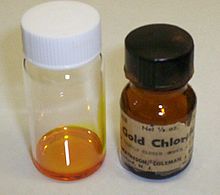Gold compounds

Gold compounds are compounds by the element
Au(III) (referred to as the auric) is a common oxidation state, and is illustrated by
Gold does not react with oxygen at any temperature[4] and, up to 100 °C, is resistant to attack from ozone.[5]
Some free
Gold does not react with sulfur directly,[9] but gold(III) sulfide can be made by passing hydrogen sulfide through a dilute solution of gold(III) chloride or chloroauric acid.
Gold readily dissolves in mercury at room temperature to form an amalgam, and forms alloys with many other metals at higher temperatures. These alloys can be produced to modify the hardness and other metallurgical properties, to control melting point or to create exotic colors.[10]
Gold is unaffected by most acids. It does not react with
Gold is similarly unaffected by most bases. It does not react with
Common
Rare oxidation states
Less common oxidation states of gold include −1, +2, and +5.
The −1 oxidation state occurs in aurides, compounds containing the Au−
Gold also has a –1 oxidation state in covalent complexes with the
Gold(II) compounds are usually
Some gold compounds exhibit aurophilic bonding, which describes the tendency of gold ions to interact at distances that are too long to be a conventional Au–Au bond but shorter than van der Waals bonding. The interaction is estimated to be comparable in strength to that of a hydrogen bond.
Well-defined cluster compounds are numerous.[12] In some cases, gold has a fractional oxidation state. A representative example is the octahedral species {Au(P(C6H5)3)}2+6.
See also
References
- S2CID 4334587.
- .
- PMID 11749494.
- UC Davis. 2 October 2013. Retrieved 1 May 2016.
- ISBN 978-0-87170-518-1.
- ISBN 978-0-12-352651-9.
- ISBN 978-0-12-352651-9.
- ^ Wiberg, Wiberg & Holleman 2001, pp. 1286–1287
- ^ a b Emery, J. F.; Ledditcotte, G. W. (May 1961). "Nuclear Science Series (NAS-NS 3036) The Radio Chemistry of Gold" (PDF). Oak Ridge, TN: National Academy of Sciences — National Research Council — Subcommittee on Radio Chemistry. US Atomic Energy Commission. Archived (PDF) from the original on 10 November 2004. Retrieved 24 February 2021.
- ^ Jewellery Alloys. World Gold Council
- .
- ^ ISBN 978-0-12-352651-9.
- PMID 18762832.
- PMID 21225974.
- .
- ISBN 978-0-85404-366-8.
- PMID 11021792.
- PMID 16639770.



![{\displaystyle {\ce {2 Au + 3 F2 ->[t] 2 AuF3}}}](https://wikimedia.org/api/rest_v1/media/math/render/svg/ff81168773c670f0d20dad637eb11c293eab2ea8)
![{\displaystyle {\ce {2 Au + 3 Cl2 ->[t] 2 AuCl3}}}](https://wikimedia.org/api/rest_v1/media/math/render/svg/2ebb268ed66673aa0145c1c0df0cc4e2190677a0)
![{\displaystyle {\ce {2 Au + 2 Br2 ->[t] AuBr3 + AuBr}}}](https://wikimedia.org/api/rest_v1/media/math/render/svg/e53e90a38d7b2135e56e55c38295b794004fbf80)
![{\displaystyle {\ce {2 Au + I2 ->[t] 2 AuI}}}](https://wikimedia.org/api/rest_v1/media/math/render/svg/3328739b5441258750c0ddcc4ac0bc47ab9316e7)
![{\displaystyle {\ce {2Au{}+6H2SeO4->[200^{\circ }C]Au2(SeO4)3{}+3H2SeO3{}+3H2O}}}](https://wikimedia.org/api/rest_v1/media/math/render/svg/67f8b0b6909b00931fc564c952a576d3447d518b)
![{\displaystyle {\ce {Au{}+4HCl{}+HNO3->H[AuCl4]{}+NO\uparrow +2H2O}}}](https://wikimedia.org/api/rest_v1/media/math/render/svg/b9bf902ad0abbf25dd39223aaba3259238a88467)